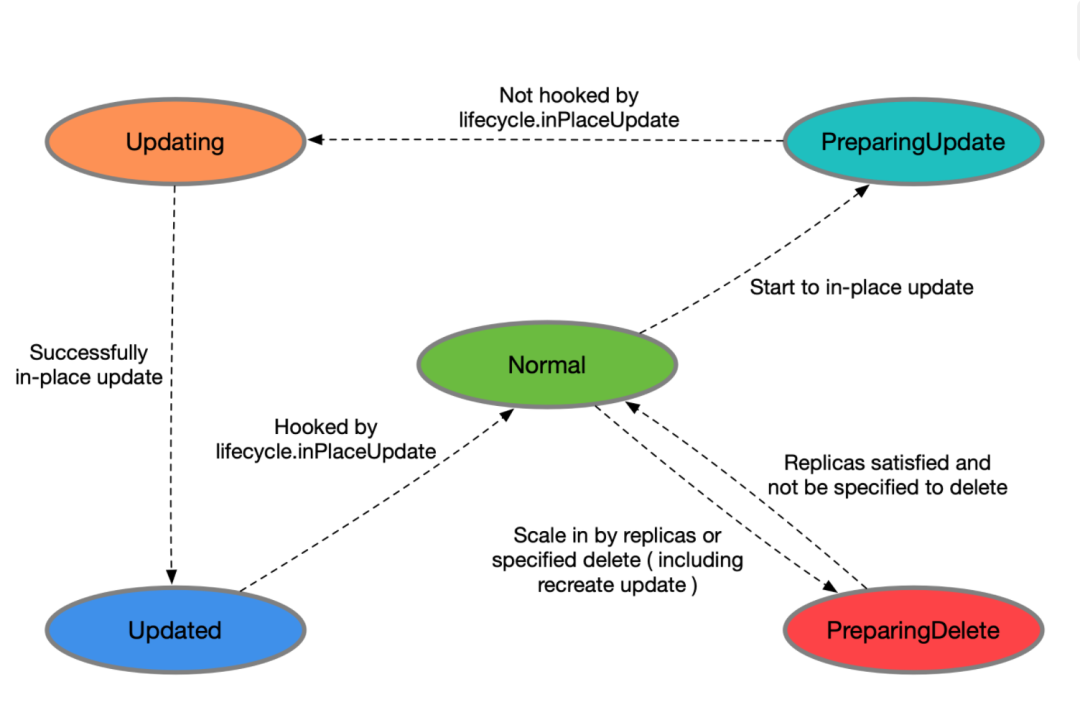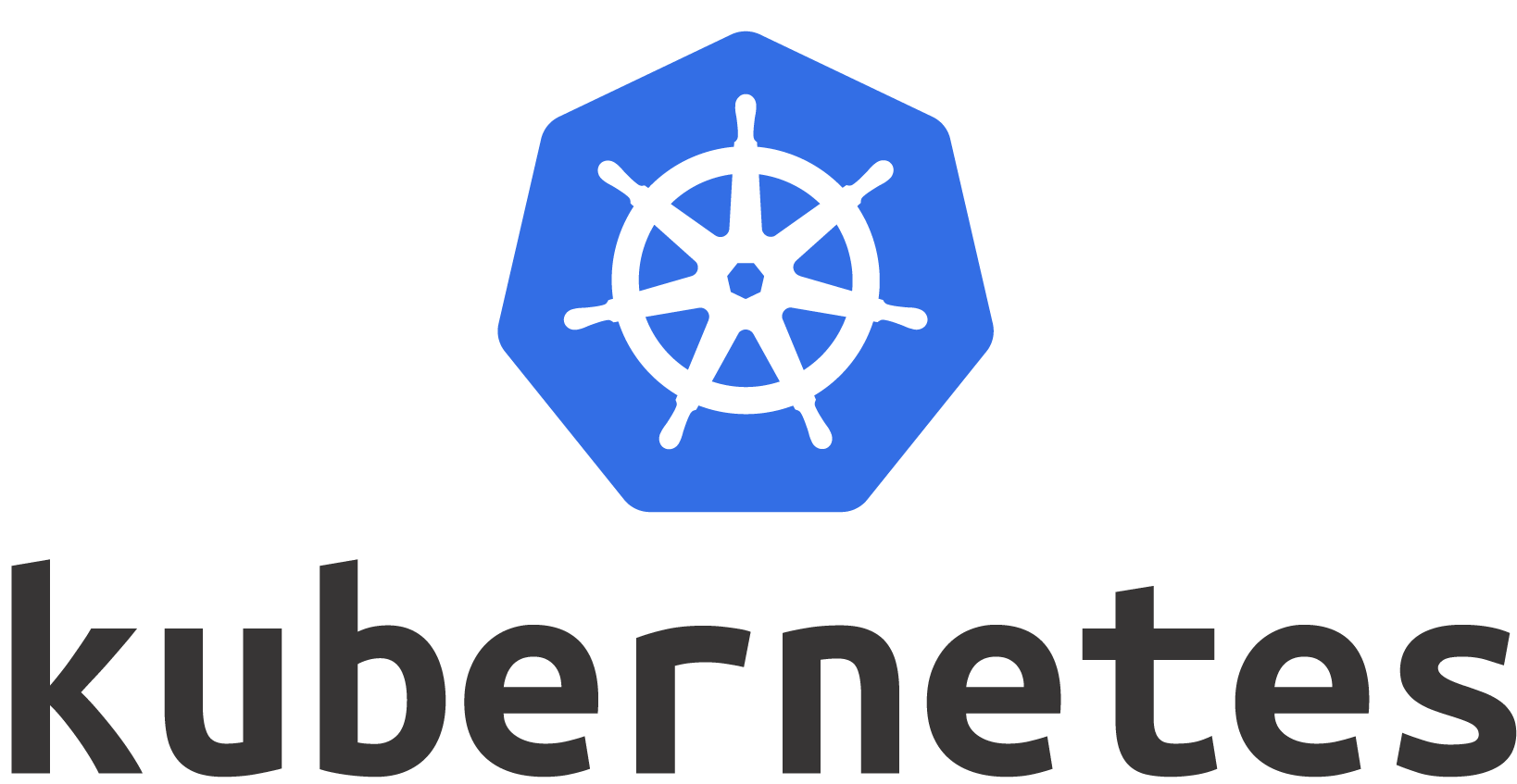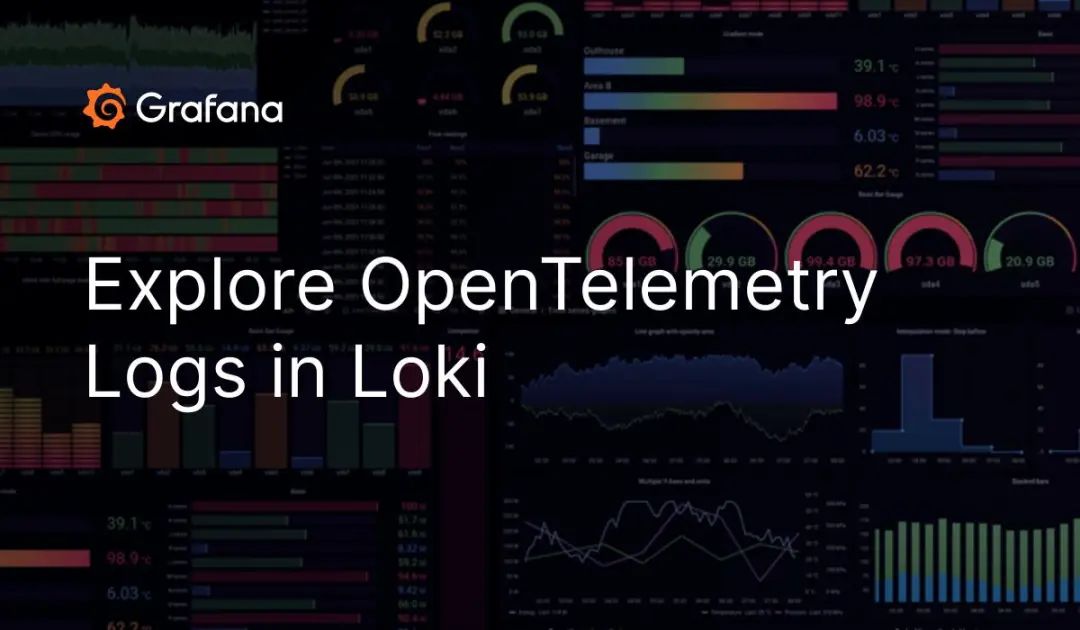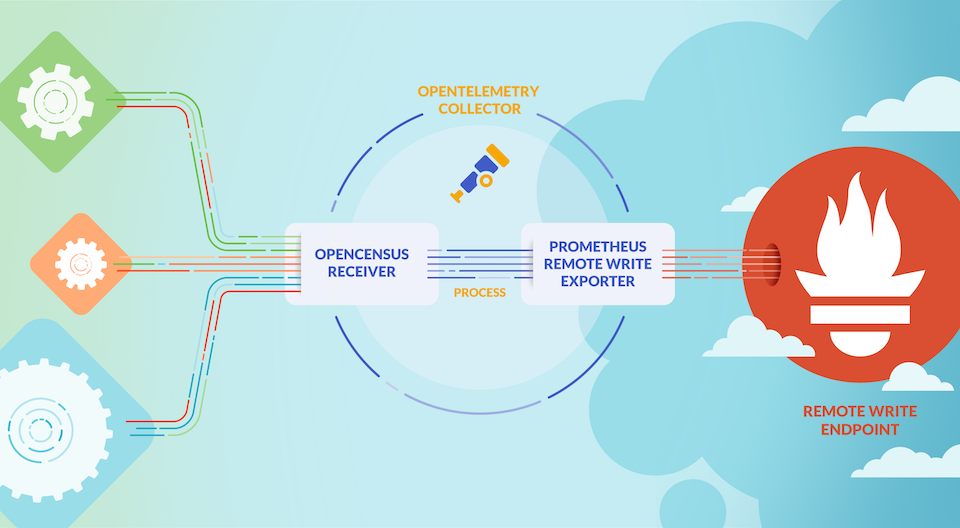OpenKruise(原名 Kubernetes 增强控制器)是一个 Kubernetes 的扩展框架,它提供了一些新的自定义控制器和 API 所需的 CRD(Custom Resource Definition)来简化应用程序生命周期管理。OpenKruise 旨在帮助开发者更加高效地管理容器应用程序,并支持更丰富、灵活的策略配置。
主要特性如下:
自动水平伸缩:提供了 DaemonSet 集群容器资源限制等高级功能,能够处理特定类型的工作负载并实现自我调整。
灰度发布:通过基于标签的访问控制和路由规则,向指定用户或环境推送应用程序版本部署更新进行测试和验证。
同步升级:支持可以同时定义多个关联对象的应用,实现“熔断”,防止服务时间达到最大值还未响应客户端请求而导致应用中断崩溃。
软件回滚:快速将服务恢复到之前选择正确状态的方法,减少故障对保证稳健运营的影响。
总之,OpenKruise 的目的是为使用 Kubernetes 运行容器的企业提供一个全面的解决方案,使他们可以轻松创建可靠、可扩展、安全和符合要求的应用程序。
openkruise 面向自动化场景的 Kubernetes workload 扩展 controller,它是一组 controller,可在应用程序工作负载管理上扩展和补充 Kubernetes 核心控制器。cloneset 在很多方面上借鉴了 statefulset ,只是没有 statefulset 的 ordinal 序号。
CloneSet CloneSet 控制器提供了高效管理无状态应用的能力,一个简单的 CloneSet yaml 文件如下:
1 2 3 4 5 6 7 8 9 10 11 12 13 14 15 16 17 18 19 apiVersion: apps.kruise.io/v1alpha1 kind: CloneSet metadata: labels: app: sample name: sample spec: replicas: 5 selector: matchLabels: app: sample template: metadata: labels: app: sample spec: containers: - name: nginx image: nginx:alpine
spec.template 中定义了当前 CloneSet 中最新的 Pod 模板。控制器会为每次更新过的 spec.template 计算一个 revision hash 值。在运行过程中,还会额外 为 cloneset 管理的pod 加上 label=controller-revision-hash 标记 pod 所属的 revision。
运行后,describe cloneset 示例:
1 2 3 4 5 6 7 8 9 10 11 12 13 14 15 16 17 18 19 20 21 22 23 Name: sample Namespace: default Labels: app=sample Annotations: API Version: apps.kruise.io/v1alpha1 Kind: CloneSet Metadata: Creation Timestamp: 2020-08-17T09:39:08Z Generation: 1 Resource Version: 307518 Self Link: /apis/apps.kruise.io/v1alpha1/namespaces/default/clonesets/sample UID: 65534592 -a998-4374-a2c7-56eeb1dd273b Spec: ... Status: Available Replicas: 5 Collision Count: 0 Label Selector: app=sample Observed Generation: 1 Ready Replicas: 5 Replicas: 5 Update Revision: sample-5cdbb7d879 Updated Ready Replicas: 5 Updated Replicas: 5
原地升级 nginx pod 的 status 示例
1 2 3 4 5 6 7 8 9 10 11 12 13 14 15 16 17 Labels: app=sample apps.kruise.io/cloneset-instance-id=75v7q controller-revision-hash=sample-549647c4b4 Annotations: inplace-update-state: {"revision" :"sample-549647c4b4" ,"updateTimestamp" :"2020-08-14T11:04:25Z" ,"lastContainerStatuses" :... } Controlled By: CloneSet/sample Status: Running // Pending/Running/Succeeded/Failed/Unknown Readiness Gates: Type Status InPlaceUpdateReady True // 原地升级添加的自定义Readiness Gates Conditions: Type Status InPlaceUpdateReady True Initialized True // 所有的 Init 容器 都已成功启动 Ready False // Pod 可以为请求提供服务,并且应该被添加到对应服务的负载均衡池中 ContainersReady False // Pod 中所有容器都已就绪 PodScheduled True // Pod 已经被调度到某节点
CloneSet 可以对标原生的 Deployment,但 CloneSet 提供了很多增强功能,比如扩缩容时删除特定 pod,尤其提供了丰富的升级策略 。
1 2 3 4 5 6 7 8 9 10 11 12 13 14 15 16 17 spec: // 升级功能 updateStrategy: type: // 升级方式,默认为重建升级ReCreate,支持尽可能原地升级InPlaceIfPossible 和 只能原地升级InPlaceOnly inPlaceUpdateStrategy: // 原地升级策略,比如graceful period 等 partition: // Partition 的语义是 保留旧版本 Pod 的数量,默认为 0 。 如果在发布过程中设置了 partition,则控制器只会将 (replicas - partition) 数量的 Pod 更新到最新版本。 MaxUnavailable: // 最大不可用的Pod数量,是一个绝对值或百分比 MaxSurge: // 最大弹性数量,即最多能扩出来超过 replicas 的 Pod 数量,是一个绝对值或百分比。 priorityStrategy: // 优先级策略,升级顺序相关 ... scatterStrategy: // 打散策略,升级顺序相关 paused: // 为true时发布暂停 PreUpdate: // 升级前钩子函数 PostUpdate: // 升级后钩子函数 // 扩缩容功能 scaleStrategy: podsToDelete: // 允许用户在缩小 replicas 数量的同时,指定想要删除的 Pod 名字
CloneSet status 中的字段说明:
status.replicas: Pod 总数
status.readyReplicas: ready Pod 数量
status.availableReplicas: ready and available Pod 数量 (满足 minReadySeconds)
status.updateRevision: 最新版本的 revision hash 值
status.updatedReplicas: 最新版本的 Pod 数量
status.updatedReadyReplicas: 最新版本的 ready Pod 数量
cloneset 作者提到:cloneset partition 其实是继承了原生 statefulset 的 partition 理念,只是没有 statefulset 的 ordinal 序号。Partition 的语义是 保留旧版本 Pod 的数量,笔者曾觉得有点违反直觉。但如果 partition 来表示新版本数量的话,每次全量发布、扩容时都应同步设置 partition 的值(与 replicas 保持一致),partition 的默认值就不能是 0 或不填了。
Reconcile 逻辑 在 kubebuilder 把 Controller 控制器模型 的代码 都自动生成之后,不同 Controller 之间的逻辑差异便只剩下 Reconcile 了
整体逻辑 背景知识
CloneSet Owned 三个资源:ControllerRevision、Pod、PVC。
控制器会为每次更新过的 spec.template 计算一个 revision hash 值并上报到 CloneSet status 中
比如上文中提到的 nginx,在创建之初拥有的第一个 template 版本,会创建一个对应的 ControllerRevision。而当修改了 image 版本之后,CloneSet Controller 会创建一个新的 ControllerRevision,可以理解为每一个 ControllerRevision 对应了每一个版本的 Template,也对应了每一个版本的 ControllerRevision hash。通过 ControllerRevision,CloneSet 可以很方便地管理不同版本的 template 模板,还原 CloneSet 。
Pod label 中定义的 ControllerRevision hash(label name = “controller-revision-hash”),就是 ControllerRevision 的名字
1 2 3 4 5 6 7 8 9 10 11 12 13 14 15 16 17 18 19 20 21 22 23 24 25 26 27 28 29 30 31 32 33 34 35 36 37 38 39 40 41 42 43 44 45 func (r *ReconcileCloneSet) error ) { return r.reconcileFunc(request) } func (r *ReconcileCloneSet) error ) { startTime := time.Now() instance := &appsv1alpha1.CloneSet{} err := r.Get(context.TODO(), request.NamespacedName, instance) coreControl := clonesetcore.New(instance) selector, err := metav1.LabelSelectorAsSelector(instance.Spec.Selector) filteredPods, filteredPVCs, err := r.getOwnedResource(instance) filteredPods, err = r.claimPods(instance, filteredPods) revisions, err := r.controllerHistory.ListControllerRevisions(instance, selector) history.SortControllerRevisions(revisions) currentRevision, updateRevision, collisionCount, err := r.getActiveRevisions(instance, revisions, clonesetutils.GetPodsRevisions(filteredPods)) newStatus := appsv1alpha1.CloneSetStatus{ ObservedGeneration: instance.Generation, CurrentRevision: currentRevision.Name, UpdateRevision: updateRevision.Name, CollisionCount: new (int32 ), LabelSelector: selector.String(), } *newStatus.CollisionCount = collisionCount delayDuration, syncErr := r.syncCloneSet(instance, &newStatus, currentRevision, updateRevision, revisions, filteredPods, filteredPVCs) if err = r.statusUpdater.UpdateCloneSetStatus(instance, &newStatus, filteredPods); err != nil { return reconcile.Result{}, err } if err = r.truncatePodsToDelete(instance, filteredPods); err != nil { klog.Warningf("Failed to truncate podsToDelete for %s: %v" , request, err) } if err = r.truncateHistory(instance, filteredPods, revisions, currentRevision, updateRevision); err != nil { klog.Errorf("Failed to truncate history for %s: %v" , request, err) } ... return reconcile.Result{RequeueAfter: delayDuration}, syncErr }
扩缩容 syncCloneSet 根据 cloneSet 期望状态( 由 replicas 以及 updateStrategy 描述 )以及 pod 的真实状态, 执行 scale 或 update 逻辑
scale 逻辑 对应 scale.Interface:
需要做扩容或缩容的时候(也就是 pod 实际数量不等于 replicas 时 ),scale 通过 删除或创建特定 Revision 的 pod 使得 新旧 Revision pod 的数量符合 replicas/partition/MaxSurge/maxUnavailable 要求
如果 pod 实际数量等于 replicas,scale 并不会进行处理,本次 syncCloneSet 主要执行 update 逻辑。
update 逻辑对应 update.Interface:找到不符合 updateRevision 的 pod,根据 partition/MaxSurge/maxUnavailable 以及 pod 的 ready 情况,计算需要更新的 pod 的数量 needToUpdateCount,从排序好的 pod 中选取 needToUpdateCount 个 pod 执行更新逻辑。PS:选择该删的删掉,之后创建
如果配置了原地升级策略, 原地升级 pod
如果是默认 ReCreate 策略,按序删除 pod
1 2 3 4 5 6 7 8 9 10 11 12 13 14 15 16 func (r *ReconcileCloneSet) instance *appsv1alpha1.CloneSet, newStatus *appsv1alpha1.CloneSetStatus, currentRevision, updateRevision *apps.ControllerRevision, revisions []*apps.ControllerRevision, filteredPods []*v1.Pod, filteredPVCs []*v1.PersistentVolumeClaim, ) (time.Duration, error ) { currentSet, err := r.revisionControl.ApplyRevision(instance, currentRevision) updateSet, err := r.revisionControl.ApplyRevision(instance, updateRevision) scaling, podsScaleErr = r.scaleControl.Manage(currentSet, updateSet, currentRevision.Name, updateRevision.Name, filteredPods, filteredPVCs) if scaling { return delayDuration, podsScaleErr } delayDuration, podsUpdateErr = r.updateControl.Manage(updateSet, updateRevision, revisions, filteredPods, filteredPVCs) return delayDuration, err }
扩容逻辑:如果发布的时候设置了 maxSurge,控制器会先多扩出来 maxSurge 数量的 Pod(此时 Pod 总数为 (replicas+maxSurge)),然后再开始发布存量的 Pod。然后,当新版本 Pod 数量已经满足 replicas - partition 要求之后,控制器会再把多余的 maxSurge 数量的 Pod 删除掉,保证最终的 Pod 数量符合 replicas。此外,maxSurge 还受 升级方式(type)的影响:maxSurge 不允许配合 InPlaceOnly 更新模式使用(可以认为此时 maxSurge=0?)。另外,如果是与 InPlaceIfPossible 策略配合使用,控制器会先扩出来 maxSurge 数量的 Pod,再对存量 Pod 做原地升级。
1 2 3 4 5 6 7 8 9 10 11 12 13 14 15 16 17 18 19 20 21 22 23 24 25 26 27 28 29 30 31 32 33 34 35 36 func (r *realControl) currentCS, updateCS *appsv1alpha1.CloneSet, currentRevision, updateRevision string , pods []*v1.Pod, pvcs []*v1.PersistentVolumeClaim, ) (bool , error ) { if podsToDelete := getPodsToDelete(updateCS, pods); len (podsToDelete) > 0 { return r.deletePods(updateCS, podsToDelete, pvcs) } updatedPods, notUpdatedPods := clonesetutils.SplitPodsByRevision(pods, updateRevision) diff, currentRevDiff := calculateDiffs(updateCS, updateRevision == currentRevision, len (pods), len (notUpdatedPods)) if diff < 0 { expectedCreations := diff * -1 expectedCurrentCreations := 0 if currentRevDiff < 0 { expectedCurrentCreations = currentRevDiff * -1 } availableIDs := getOrGenAvailableIDs(expectedCreations, pods, pvcs) return r.createPods(expectedCreations, expectedCurrentCreations, currentCS, updateCS, currentRevision, updateRevision, availableIDs.List(), existingPVCNames) } else if diff > 0 { podsToDelete := choosePodsToDelete(diff, currentRevDiff, notUpdatedPods, updatedPods) return r.deletePods(updateCS, podsToDelete, pvcs) } return false , nil }
更新逻辑
1 2 3 4 5 6 7 8 9 10 11 12 13 14 15 16 17 18 19 20 21 22 23 24 25 26 27 28 29 30 31 32 33 34 35 36 37 38 39 40 41 42 43 44 45 46 47 48 49 50 51 52 53 54 func (c *realControl) updateRevision *apps.ControllerRevision, revisions []*apps.ControllerRevision, pods []*v1.Pod, pvcs []*v1.PersistentVolumeClaim, ) (time.Duration, error ) { var waitUpdateIndexes []int for i := range pods { if clonesetutils.GetPodRevision(pods[i]) != updateRevision.Name { waitUpdateIndexes = append (waitUpdateIndexes, i) } } needToUpdateCount := calculateUpdateCount(coreControl, cs.Spec.UpdateStrategy, cs.Spec.MinReadySeconds, int (*cs.Spec.Replicas), waitUpdateIndexes, pods) if needToUpdateCount < len (waitUpdateIndexes) { waitUpdateIndexes = waitUpdateIndexes[:needToUpdateCount] } for _, idx := range waitUpdateIndexes { pod := pods[idx] if duration, err := c.updatePod(cs, coreControl, updateRevision, revisions, pod, pvcs); err != nil {...} } return requeueDuration.Get(), nil } func (c *realControl) updateRevision *apps.ControllerRevision, revisions []*apps.ControllerRevision, pod *v1.Pod, pvcs []*v1.PersistentVolumeClaim, ) (time.Duration, error ) { if cs.Spec.UpdateStrategy.Type == appsv1alpha1.InPlaceIfPossibleCloneSetUpdateStrategyType || cs.Spec.UpdateStrategy.Type == appsv1alpha1.InPlaceOnlyCloneSetUpdateStrategyType { var oldRevision *apps.ControllerRevision for _, r := range revisions { if r.Name == clonesetutils.GetPodRevision(pod) { oldRevision = r break } } res := c.inplaceControl.Update(pod, oldRevision, updateRevision, coreControl.GetUpdateOptions()) ... return ... } if err := c.Delete(context.TODO(), pod); err != nil { return 0 , err } return 0 , nil }
虽然 spec.updateStrategy.partition 指定了旧版的数量。但 update 逻辑的主要目的是 更新 (replicas - partition) 个 updateRevision 实例。如果连续多次灰度发布,则旧版 可能存在多个 revision(也就是说不是最新的 revision 都是旧版,旧版不都是某一个 revision),整个 cloneset 可能存在 2 个以上 revision 的 pod。这与直觉上的 多版本 pod 管理 还是不一样的
高级特性 原地升级 如何为 Kubernetes 实现原地升级?如何在 Kubernetes 中实现容器原地升级一个 Pod 中可能包含了主业务容器,还有不可剥离的依赖业务容器,以及 SideCar 组件容器等,如果因为要更新其中一个 SideCar Container 而继续按照 ReCreate Pod 的方式进行整个 Pod 的重建,那负担还是很大的。更新一个轻量的 SideCar 却导致了分钟级的单个 Pod 的重建过程,因此,我们迫切希望能实现,只升级 Pod 中的某个 Container,而不用重建整个 Pod。
Kubernetes 把容器原地升级的能力只做在 Kubelet 这一层,并没有暴露在 Deployment、StatefulSet 等 Controller 中直接提供给用户,原因很简单,还是建议大家把 Pod 作为完整的部署单元。为了实现容器原地升级,我们更改 Pod.Spec 中对应容器的 Image,就会生成 kubetypes.UPDATE 类型的事件,kubelet 将容器优雅终止。旧的容器被杀死之后,kubelet 启动新的容器,如此即完成 Pod 不重建的前提下实现容器的原地升级。
不过这样可能存在的几个风险:
容器 升级时 有一段时间服务不可用,但 k8s 组件 无法感知,这用到了 readinessGates. Your application can inject extra feedback or signals into PodStatus: Pod readiness. To use this, set readinessGates in the Pod’s spec to specify a list of additional conditions that the kubelet evaluates for Pod readiness.Readiness gates are determined by the current state of status.condition fields for the Pod. If Kubernetes cannot find such a condition in the status.conditions field of a Pod, the status of the condition is defaulted to “False”. 当一个 Pod 被原地升级时,控制器会先利用 readinessGates 把 Pod status 中修改为 not-ready 状态,然后再更新 Pod spec 中的 image 字段来触发 Kubelet 重建对应的容器。
有时候 Kubelet 重建容器太快,还没等到其他控制器如 endpoints-controller 感知到 Pod not-ready,可能会导致流量受损。因此又在原地升级中提供了 graceful period 选项,作为优雅原地升级的策略。用户如果配置了 gracePeriodSeconds 这个字段,控制器在原地升级的过程中会先把 Pod status 改为 not-ready,然后等一段时间(gracePeriodSeconds),最后再去修改 Pod spec 中的镜像版本。这样,就为 endpoints-controller 这些控制器留出了充足的时间来将 Pod 从 endpoints 端点列表中去除。
1 2 3 4 5 6 7 8 9 10 11 12 13 14 15 16 17 18 19 20 21 22 23 24 25 26 27 28 29 30 31 32 33 34 35 36 37 38 39 40 41 42 43 44 45 46 47 48 49 50 51 52 func (c *realControl) var spec *UpdateSpec if opts == nil || opts.CustomizeSpecCalculate == nil { spec = calculateInPlaceUpdateSpec(oldRevision, newRevision) } if opts != nil && opts.GracePeriodSeconds > 0 { spec.GraceSeconds = opts.GracePeriodSeconds } if containsReadinessGate(pod) { newCondition := v1.PodCondition{ Type: appsv1alpha1.InPlaceUpdateReady, LastTransitionTime: c.now(), Status: v1.ConditionFalse, Reason: "StartInPlaceUpdate" , } if err := c.updateCondition(pod, newCondition); err != nil { return UpdateResult{InPlaceUpdate: true , UpdateErr: err} } } if err := c.updatePodInPlace(pod, spec, opts); err != nil { return UpdateResult{InPlaceUpdate: true , UpdateErr: err} } ... } func (c *realControl) error { return retry.RetryOnConflict(retry.DefaultBackoff, func () error { clone, err := c.adp.getPod(pod.Namespace, pod.Name) if c.revisionKey != "" { clone.Labels[c.revisionKey] = spec.Revision } inPlaceUpdateStateJSON, _ := json.Marshal(inPlaceUpdateState) clone.Annotations[appsv1alpha1.InPlaceUpdateStateKey] = string (inPlaceUpdateStateJSON) if spec.GraceSeconds <= 0 { if clone, err = patchUpdateSpecToPod(clone, spec, opts); err != nil { return err } delete (clone.Annotations, appsv1alpha1.InPlaceUpdateGraceKey) } else { inPlaceUpdateSpecJSON, _ := json.Marshal(spec) clone.Annotations[appsv1alpha1.InPlaceUpdateGraceKey] = string (inPlaceUpdateSpecJSON) } return c.adp.updatePod(clone) }) }
计算待更新 pod 的 spec ,condition,container status 等数据, 加上 revision label, inplace-update-grace annotation ,最终使用 k8s api 更新 pod 到 k8s cluster
协程间同步状态 事件一直在产生 并由不同的协程处理, 如果一个协程正在对 cloneset 做扩容操作,那么另一个协程需要等待一下,所以需要一个协程间的协调机制。
1 2 3 4 5 6 7 8 9 10 11 12 type ScaleExpectations interface { ExpectScale(controllerKey string , action ScaleAction, name string ) ObserveScale(controllerKey string , action ScaleAction, name string ) SatisfiedExpectations(controllerKey string ) (bool , time.Duration, map [ScaleAction][]string ) DeleteExpectations(controllerKey string ) GetExpectations(controllerKey string ) map [ScaleAction]sets.String } type realScaleExpectations struct { sync.Mutex controllerCache map [string ]*realControllerScaleExpectations }
一个协程进行某操作前先 ExpectScale,操作完成后再 ObserveScale,另一个协程可以通过 SatisfiedExpectations 来检查 操作是否完成。
1 2 3 4 5 6 7 8 9 10 11 12 13 14 15 16 17 18 19 20 21 22 23 24 25 26 27 28 29 30 func (r *realControl) for _, p := range newPods { clonesetutils.ScaleExpectations.ExpectScale(clonesetutils.GetControllerKey(updateCS), expectations.Create, p.Name) podsCreationChan <- p } ... for _, pod := range newPods { if _, ok := successPodNames.Load(pod.Name); !ok { clonesetutils.ScaleExpectations.ObserveScale(clonesetutils.GetControllerKey(updateCS), expectations.Create, pod.Name) } } } func (r *ReconcileCloneSet) error ) { ... if scaleSatisfied, unsatisfiedDuration, scaleDirtyPods := clonesetutils.ScaleExpectations.SatisfiedExpectations(request.String()); !scaleSatisfied { if unsatisfiedDuration >= expectations.ExpectationTimeout { klog.Warningf("Expectation unsatisfied overtime for %v, scaleDirtyPods=%v, overtime=%v" , request.String(), scaleDirtyPods, unsatisfiedDuration) return reconcile.Result{}, nil } klog.V(4 ).Infof("Not satisfied scale for %v, scaleDirtyPods=%v" , request.String(), scaleDirtyPods) return reconcile.Result{RequeueAfter: expectations.ExpectationTimeout - unsatisfiedDuration}, nil } ... }
通过操作 pod 来影响 cloneset 的策略 1 2 3 4 5 6 7 8 9 10 11 12 13 14 15 apiVersion: apps.kruise.io/v1alpha1 kind: CloneSet spec: updateStrategy: priorityStrategy: weightPriority: - weight: 50 matchSelector: matchLabels: test-key: foo - weight: 30 matchSelector: matchLabels: test-key: bar
在操作 cloneset 发布之前,为 pod 打上 label,则 test-key=foo 会比 test-key= bar 的 pod 先升级。
CloneSet 管理的 Pod 有以下状态
Normal:正常状态
PreparingUpdate: 准备原地升级
Updating: 原地升级中
Updated:原地升级完成
PreparingDelete:准备删除
1 2 3 4 5 6 7 8 9 10 11 12 13 14 15 16 apiVersion: apps.kruise.io/v1alpha1 kind: CloneSet spec: lifecycle: preDelete: finalizersHandler: - example.io/unready-blocker inPlaceUpdate: finalizersHandler: - example.io/unready-blocker lifecycle: inPlaceUpdate: labelsHandler: example.io/block-unready: "true"
如果定义了 lifecycle hook /preDelete,cloneset 先只将 Pod 状态改为 PreparingDelete,当开发移除 label/finalizer 后,kruise 才执行 Pod 删除,否则会直接删除 pod。PS:也就是说,如果没有定义 lifecycle hook/preDelete,pod 是没有 PreparingDelete 状态的。








